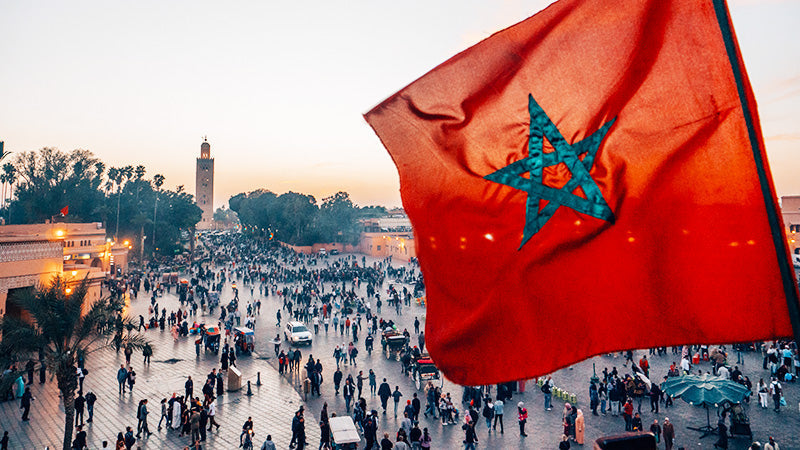
A Journey Through Moroccan History: From the Kingdom of Mauritania to Modern Morocco
Share
Morocco, a land of vibrant culture, breathtaking landscapes, and rich history, has been a crossroads of civilizations for millennia. Its story is one of empires, dynasties, and a unique blend of Amazigh, Arab, African, and European influences. To truly understand Morocco's history, we must begin with its ancient roots, tracing back to the Kingdom of Mauritania, and follow its evolution into the modern nation we know today.
The Kingdom of Mauritania: Ancient Beginnings
Long before Morocco became a unified nation, the region was home to the ancient Kingdom of Mauritania (not to be confused with the modern-day country of Mauritania). This Amazigh kingdom flourished in the 3rd century BCE, spanning parts of modern-day Morocco and Algeria. The Mauritanians were skilled traders, farmers, and warriors, and their kingdom was a significant player in the Mediterranean world.
The most famous ruler of this kingdom was King Juba II, an Amazigh king who was also a Roman client ruler. Juba II was a scholar and a patron of the arts, and his reign marked a period of cultural and economic prosperity. However, the kingdom eventually fell under Roman control in 40 CE, becoming the Roman province of Mauretania Tingitana.
The Arrival of Islam and the Birth of Moroccan Dynasties
The 7th century CE brought a transformative force to North Africa: Islam. Arab armies swept across the region, bringing with them a new religion, language, and culture. By the 8th century, Morocco had become a center of Islamic learning and power.
The Idrisid dynasty, founded by Idris I in 788 CE, is often considered the first true Moroccan state. Idris I, a descendant of the Prophet Muhammad, established the city of Fes, which became a cultural and religious hub. The Idrisids laid the foundation for Morocco's identity as an Islamic kingdom, blending Arab and Amazigh traditions.
The Golden Age of Moroccan Empires
Morocco's history is marked by a series of powerful dynasties that expanded its influence across North Africa and beyond.
-
The Almoravids (1040–1147 CE): This Amazigh dynasty emerged from the Sahara and united Morocco under a strict interpretation of Islam. They extended their empire into Spain, creating a vast transcontinental state that connected the Maghreb and Al-Andalus.
-
The Almohads (1121–1269 CE): Another Amazigh dynasty, the Almohads, overthrew the Almoravids and established an even larger empire. Under their rule, Morocco became a center of learning, architecture, and trade. The iconic Koutoubia Mosque in Marrakech stands as a testament to their architectural legacy.
-
The Marinids (1244–1465 CE): The Marinids continued Morocco's tradition of cultural and intellectual flourishing. They built madrasas (Islamic schools) and fortified cities, leaving a lasting impact on Moroccan architecture.
The Saadi and Alaouite Dynasties: Resilience and Renewal
In the 16th century, the Saadi dynasty rose to power, defending Morocco against European invasions and Ottoman expansion. Their most famous ruler, Ahmed al-Mansur, led a golden age of prosperity and expanded Morocco's influence into West Africa.
The Saadis were succeeded by the Alaouite dynasty in the 17th century, which continues to rule Morocco to this day. The Alaouites faced numerous challenges, including European colonialism, but they managed to maintain Morocco's independence while modernizing the country.
Colonialism and the Struggle for Independence
In the 19th and early 20th centuries, Morocco became a target for European powers. France and Spain established protectorates over Morocco in 1912, dividing the country into zones of influence. However, the Moroccan people fiercely resisted colonial rule, culminating in the independence movement led by Sultan Mohammed V and the Istiqlal Party.
Morocco regained its independence in 1956, and Mohammed V became the first king of modern Morocco. His son, Hassan II, and grandson, Mohammed VI, have since guided the country through periods of political reform, economic development, and cultural preservation.
Modern Morocco: A Bridge Between Continents
Today, Morocco is a vibrant nation that proudly embraces its rich history while looking toward the future. It is a constitutional monarchy with a diverse population and a thriving economy. Cities like Casablanca, Rabat, and Marrakech are bustling hubs of commerce, culture, and tourism.
Morocco's unique position as a bridge between Africa, Europe, and the Arab world has made it a key player in regional and global affairs. Its ancient medinas, majestic mountains, and sweeping deserts continue to captivate visitors, while its people carry forward the legacy of their ancestors.
A Tapestry of Time
Morocco's history is a tapestry woven from the threads of ancient Amazigh kingdoms, Islamic empires, and colonial struggles. From the Kingdom of Mauritania to the modern Alaouite dynasty, Morocco has endured and thrived, shaping a unique identity that reflects its diverse heritage. As we explore its past, we gain a deeper appreciation for the resilience and richness of this remarkable nation.
Whether you're wandering through the ruins of Volubilis, marveling at the intricate mosaics of Fes, or sipping mint tea in a Marrakech riad, you're stepping into a story that spans thousands of years—a story that continues to unfold with each passing day